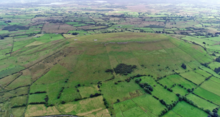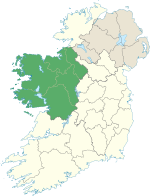Contents

Knocknashee (Irish: Cnoc na Sí) is a 276-metre (906 ft) Marilyn in the Ox Mountains, County Sligo, Ireland.
Geography
The River Moy rises at the foot of Knocknashee.
Geology
Knocknashee hill consists of a limestone top with shales underlying the lower slopes.[2]
Archaeology
Knocknashee was identified as a hilltop fort in 1988. It is an enclosed hill fort with limestone ramparts containing cairns, burial chambers and hutsites. The fort is 700 metres long and 320 metres wide and is enclosed by two earth and stone ramparts covering an area of 53 acres. The site was discovered during an aerial survey of county Sligo by the Office of Public Works in 1988.
Name
The name of the plateau itself comes from Irish, ‘knock’ (cnoc) meaning ‘hill’ and ‘shee’ (sí) meaning ‘burial mound’ or 'of the fairies'. In older Irish Knocknashee is known as Mullinabreena.
Popular culture references
"Knocknashee" was a play by Irish playwright Deirdre Kinahan. It was first produced 24 January 2002 in the Civic Theatre, Tallaght, Dublin 24.[3]
"The Hills Of Knocknashee" is a traditional Irish song. The River Moy so gently flows from there unto the sea. Farewell to you, farewell to all from the hill of Knocknashee [4]
"Knocknashee" with music by Neil Martin and lyrics by Brendan Graham.[5]
In the 1959 film Darby O'Gill and the Little People, a hill named Knocknasheega plays a central role in the film's story as the home of a tribe of leprechauns and their king, Brian Connors. Despite sharing a similar name however, the hill bears no resemblance to the real Knocknashee, having a prominent ruined castle on its summit and being located in County Kerry, based on the nearby town being mentioned as within the proximity of Cahersiveen.
References
- ^ Mountain Views http://mountainviews.ie/mv/index.php
- ^ GSI Knocknashee Hill http://www.gsi.ie/Education/Sites_Walks_Field+Trips/Knocknashee+Hill.htm
- ^ Irish playography "Knocknashee" http://www.irishplayography.com/search/play.aspx?la=en&play_id=235[permanent dead link]
- ^ "The Hills Of Knocknashee" lyrics and chords http://www.martindardis.com/id818.html
- ^ "Knocknashee" lyrics http://www.anthonykearns.net/KnocknasheeLyrics.html Archived 2010-08-12 at the Wayback Machine


